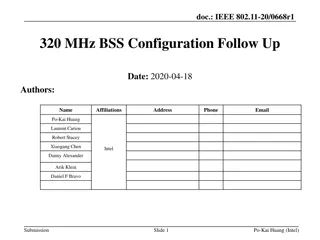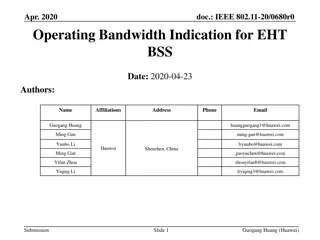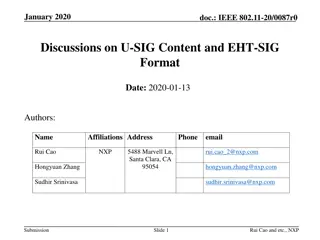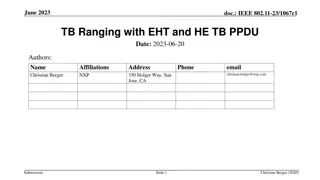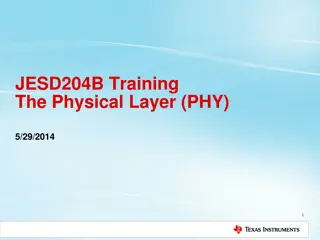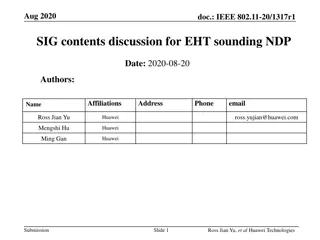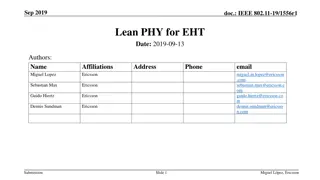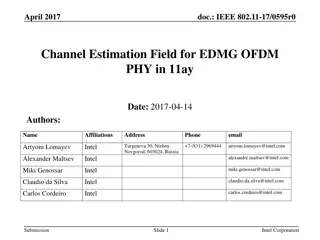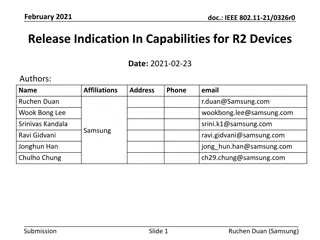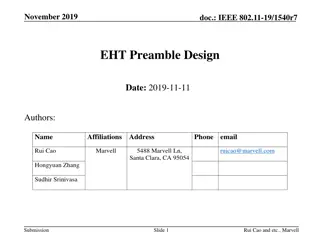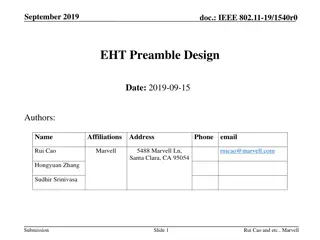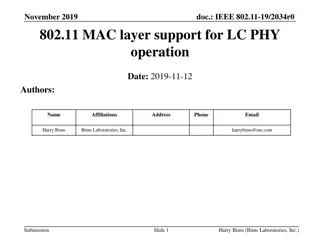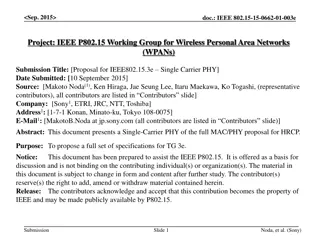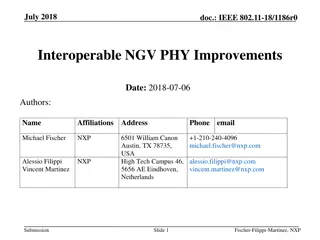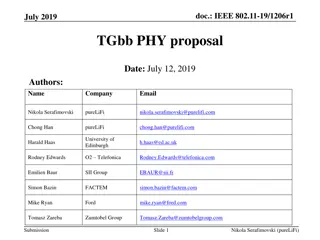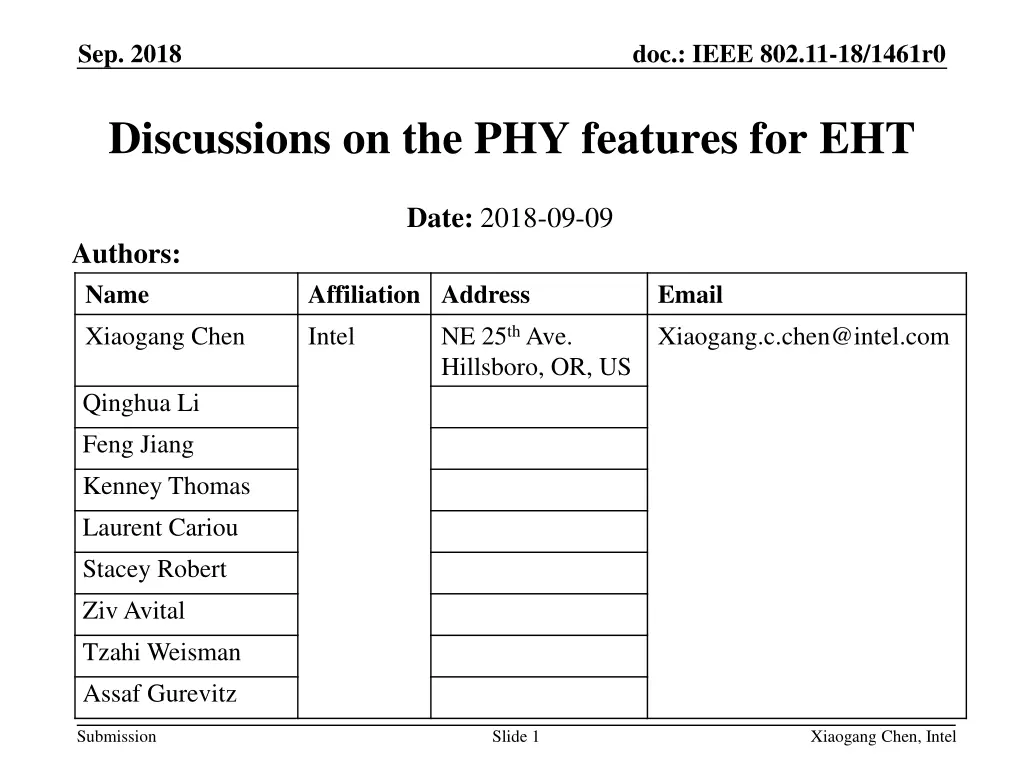
Discussions on IEEE 802.11 EHT PHY Features and Potential Topics
Explore the detailed discussions on the physical layer (PHY) features for Extreme High Throughput (EHT) in the IEEE 802.11 standard. Delve into the considerations, assumptions, and potential features for EHT, including the formation of an EHT Study Group, operating bands, coexistence with incumbents, and possible PHY enhancements like collocated MIMO, multi-user MIMO, and higher modulation schemes. Stay informed about the advancements in wireless networking technologies!
Download Presentation

Please find below an Image/Link to download the presentation.
The content on the website is provided AS IS for your information and personal use only. It may not be sold, licensed, or shared on other websites without obtaining consent from the author. If you encounter any issues during the download, it is possible that the publisher has removed the file from their server.
You are allowed to download the files provided on this website for personal or commercial use, subject to the condition that they are used lawfully. All files are the property of their respective owners.
The content on the website is provided AS IS for your information and personal use only. It may not be sold, licensed, or shared on other websites without obtaining consent from the author.
E N D
Presentation Transcript
Sep. 2018 doc.: IEEE 802.11-18/1461r0 Discussions on the PHY features for EHT Date: 2018-09-09 Authors: Name Xiaogang Chen Affiliation Address Intel Email Xiaogang.c.chen@intel.com NE 25th Ave. Hillsboro, OR, US Qinghua Li Feng Jiang Kenney Thomas Laurent Cariou Stacey Robert Ziv Avital Tzahi Weisman Assaf Gurevitz Submission Slide 1 Xiaogang Chen, Intel
Sep. 2018 doc.: IEEE 802.11-18/1461r0 Outline Recapture of SG motions PHY design assumptions for EHT Potential PHY topics in EHT Summary Submission Slide 2 Xiaogang Chen, Intel Corporation
Sep. 2018 doc.: IEEE 802.11-18/1461r0 Recapture of SG motions Move to approve formation of an EHT SG (Extreme High Throughput Study Group) to develop a Project Authorization Request (PAR) and a Criteria for Standards Development (CSD) for a new 802.11 amendment for operating in the bands between 1 to 7.125 GHz, with the primary objectives: o To increase peak throughput and improve efficiency o To support high throughput and low latency applications such as video- over-WLAN, gaming, AR and VR With target start of the task group in May 2019 Submission Slide 3 Xiaogang Chen, Intel Corporation
Sep. 2018 doc.: IEEE 802.11-18/1461r0 Consideration on the assumptions in EHT Operating band EHT STAs are able to work in 6GHz, 5GHz and 2.4GHz band. Only have EHT/HE/non-HT PPDU in 6GHz. Non-HT is used to carry short packet; Mode reduction (no VHT/HT modes in 6GHz) to simplify test. Channelization Include 20MHz/40MHz/80MHz/160MHz/320MHz in 6GHz band. Submission Slide 4 Xiaogang Chen, Intel Corporation
Sep. 2018 doc.: IEEE 802.11-18/1461r0 Consideration on the assumptions in EHT (Cont d) Coexistence with incumbents Master devices (AP) indicates the available channels in 6GHz. Master devides get these information from, e.g. data base. Subchannel/RU puncturing is used to accommodate the disabled frequency segment(s). Minimum CCA granularity is 20MHz Finer granularity will create significant changes in preamble design; Power of incumbents may be ignored in ED. Submission Slide 5 Xiaogang Chen, Intel Corporation
Sep. 2018 doc.: IEEE 802.11-18/1461r0 Potential EHT PHY Features Collocated MIMO 16 SS MUMIMO could be the beneficiary of 16SS; 16SS could be optional for EHT AP given reasonable feedback overhead; Implicit FB; One end (AP) calibration. More efficient explicit FB. 4096 QAM Keep the cadence of introducing a new modulation level per WiFi generation; 64QAM-> 11n; 256QAM-> 11ac; 1024QAM-> 11ax; 4096QAM-> EHT Feature of eye catcher for marketing; Be applied only if beamforming is used; No new EVM requirement for 4096 QAM; BF gain compensates EVM gap (-35dB instead of -42dB); Expect more BF gain as long as more antennas are deployed. Submission Slide 6 Xiaogang Chen, Intel Corporation
Sep. 2018 Potential EHT PHY Features Collocated MIMO (cont d) doc.: IEEE 802.11-18/1461r0 UL CQI measurement / UL Power control UL CQI helps TB RU selection; Efficient UL Power control is key to UL MUMIMO; Implementation based solutions AP uses reciprocal CQI in DL DL CQI is not a good reference due to BF; Unbalanced number of Tx/Rx antennas. AP leverages the UL traffic for CQI measurement / Power control UL BF can be applied in the client side and is transparent to AP; Data is not as efficient as NDP; Less STAs can be measured within one shot. Limited by Rx antennas at AP; Longer duration. NDP Short Feedback Can accommodate large number of STAs; But very sparse tone allocation. Submission Slide 7 Xiaogang Chen, Intel Corporation
Sep. 2018 Potential EHT PHY Features Collocated MIMO (cont d) UL CQI measurement / Power control Potential solution in EHT UL NDP Has been defined in 11az; Can be used for implicit beamforming; Can be leveraged for UL CQI measurement / power control. doc.: IEEE 802.11-18/1461r0 Submission Slide 8 Xiaogang Chen, Intel Corporation
Sep. 2018 doc.: IEEE 802.11-18/1461r0 Potential EHT PHY Features Distributed MIMO Distributed MIMO (detailed analysis in back up slides) Multi-AP Some fancy design could complicate the implementation and defer EHT timeline; Simpler solutions need to be prioritized. Light coordination in Time/Frequency Less PHY changes comparing with the other two schemes. Nulling Coordination could be very complicated; Be polite to neighbor STAs is not free; Simplified version may be feasible with the sacrifice of flexibility; Joint processing The most complicated one from higher layer to PHY layer; Need extensive evaluation to justify the benefits. Submission Slide 9 Xiaogang Chen, Intel Corporation
Sep. 2018 doc.: IEEE 802.11-18/1461r0 Potential EHT PHY Features Distributed MIMO (Cont d) Sounding feedback for distributed MIMO Use 11ax sounding procedure as baseline; Minimize the feedback modes on the client side; May need other feedback modes (besides the modes in 11ax) depends on the category of coordination. Submission Slide 10 Xiaogang Chen, Intel Corporation
Sep. 2018 doc.: IEEE 802.11-18/1461r0 Potential EHT PHY Features - Preamble Green field preamble is not a good practice due to backward compatibility. Auto detection Need to differentiate EHT, HE, non-HT, HT and VHT PPDU; It s better to have a future proof solution instead of debating in every generation; It s better if early termination can be achieved for intra PPDU power saving. 11n STA treat 11ac/11ax PPDU as 11a PPDU; 11ac STA treat 11ax PPDU as 11a PPDU and decode the whole PPDU; 11ac/11ax treat EHT PPDU as ?? EHT-SIGB HE-SIGB information is well organized but frequency mapping is messy; Duplicated structure (1/2/1/2) over optimize the performance for wider BW and waste resource A decent frequency mapping scheme can be considered. Submission Slide 11 Xiaogang Chen, Intel Corporation
Sep. 2018 doc.: IEEE 802.11-18/1461r0 Potential EHT PHY Features Tone Plan Physical 20MHz boundary is not aligned with the 242 tone RU of 80MHz PPDU in 11ax. Troubles keep popping up in 11ax already; Better to apply an easy fix in EHT. 320MHz channel in 6GHz. Extend the 80MHz tone plan is a simpler approach; Collecting null tones (DC/Guard) with a new tone plan has marginal gain. Submission Slide 12 Xiaogang Chen, Intel Corporation
Sep. 2018 Potential EHT PHY Features Incumbent Coexistence doc.: IEEE 802.11-18/1461r0 11ax disabled subchannel could be a starting point; Finer puncturing granularities can be added; ~25% incumbents in 6GHz have BW <= 10MHz E.g. finer granularity can be 5 or 10MHz including guard. Requirements for RU puncturing; Defining a mask DL Mask only as 11ax; Or DL+UL Mask. Leave to implementation More chance to be identified and blocked if a STA interferes incumbents Submission Slide 13 Xiaogang Chen, Intel Corporation
Sep. 2018 Potential EHT PHY Features MultiBand Operation doc.: IEEE 802.11-18/1461r0 Mostly MAC Topic; MAC layer aggregation should be prioritized; Assuming MAC aggregation can solve most issues; PHY layer aggregation is considered only if critical issue is passed to PHY. Submission Slide 14 Xiaogang Chen, Intel Corporation
Sep. 2018 doc.: IEEE 802.11-18/1461r0 Summary To meet the tight timeline of EHT, essential PHY topics should be prioritized Preamble design; Tone plan; Incumbent Coex; Collocated MIMO enhancement; Distributed MIMO with minimal PHY changes; MultiBand (if anything pass to PHY). Submission Slide 15 Xiaogang Chen, Intel Corporation
Sep. 2018 doc.: IEEE 802.11-18/1461r0 Back up Analysis of the PHY impacts from distributed MIMO Submission Slide 16 Xiaogang Chen, Intel Corporation
Sep. 2018 doc.: IEEE 802.11-18/1461r0 Frequency coordination After the Master AP split the whole band (e.g. 80MHz) into subbands (e.g. 40MHz x 2). The coordinated APs Option I: use 40MHz mask and transmit 40MHz PPDU (BW = 40MHz in SIGA); Option II: use 80MHz mask and transmit 80MHz PPDU (BW = 80MHz in SIGA) with multi-AP OFDMA. Populate energy on 40MHz. Options I II Almost no PHY changes Smooth AP transition and transparent to clients Pros Temporarily Mask change back and force; lose the flexibility of non-contiguous 40MHz; receive preamble on S20; Need preamble & data boundary alignments; receive preamble on S20. Cons Submission Slide 17 Xiaogang Chen, Intel Corporation
Sep. 2018 doc.: IEEE 802.11-18/1461r0 Nulling Coordinating procedure could be complicated (next page) Victim STAs identify interferer and report to master AP; Master AP schedule nulling on different frequency; Persecution AP sound the victim STA in neighbor BSS; Persecution AP apply nulling in data Tx in nulling widow. Challenges Create nulling for neighbor STA also reduce the freedom of persecution AP itself; Feasible for AP with larger number of antennas; Limited flexibility to null multiple directions; If pursuing to this direction, better to keep one nulling direction per RU for simplicity Submission Slide 18 Xiaogang Chen, Intel Corporation
Sep. 2018 doc.: IEEE 802.11-18/1461r0 Nulling (cont d) Non-AP STA_1 measure RSSI, read BSS color and Identify dominant interference Non-AP STA Report the STA-ID of itself to the associated AP_s1 AP_s1 report this information to the Master AP Time Frequency Master AP creates nulling time window during which persecution AP supposed to create nulling in Freq_1 for STA_1 Null 1 STA_1 Null 2 STA_2 Null 3 STA_3 Null 4 Master AP persecution AP sound STA_1 to collect nulling information in Freq_1 persecution AP apply nulling during nulling window in Freq_1 (Best effort) AP_s2(Persecution AP) AP_s1 (Victim AP) STA_2 (Victim non-AP STA) AP_s1 schedule STA_1 in Freq_1 during nulling window STA_3 STA_1 (Victim non-AP STA) Submission Slide 19 Xiaogang Chen, Intel Corporation
Sep. 2018 doc.: IEEE 802.11-18/1461r0 Joint processing Clock drifting between two APs Could introduce FFT window offset, Frequency offset between two APs; Sounding feedback may not match the channel when data is sent; Clock drifting during data transmission is hard to trace and compensate. Power imbalance between antennas Create illed-conditioned channel; The impact need further evaluation. Submission Slide 20 Xiaogang Chen, Intel Corporation


